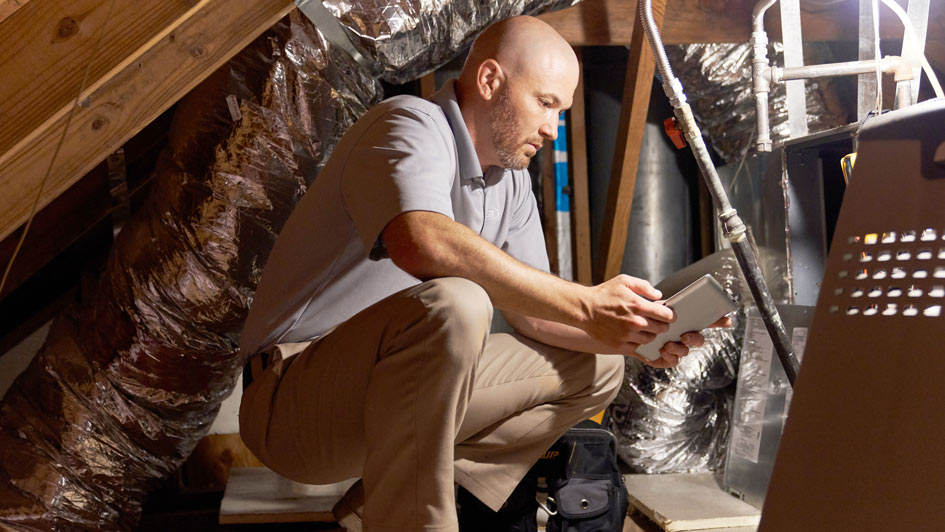
Would you believe that more than half of your home’s energy costs are needed for your heating and cooling? This is the reason why it’s critical to maintain an energy-efficient HVAC system.
Furnace efficiency standards were last revised to an Annual Fuel Utilization Efficiency (AFUE) rating of 80% in 2015. This rating system illustrates how effective your furnace is at converting natural gas into heat. An AFUE rating of 80% means your furnace wastes about 20% of the fuel it uses while creating heat.
In 2022, the U.S. government devised new energy-efficiency standards for residential gas furnaces that would significantly decrease emissions, save homeowners money and promote sustainability.
These revised standards are anticipated to:
- Save Americans $1.9 billion annually.
- Reduce carbon emissions by 373 million metric tons and methane emissions by 5.1 million tons over the next 25 - 30 years, the equivalent of what 61 million homes emit yearly.
Starting in 2029, the proposed rule would require all new gas furnaces to feature AFUE ratings of 95%. This means furnaces would combust nearly 100% of the gas into usable heat.
With these facts in mind, you may be asking yourself "what happens to my existing furnace"? Currently, next to nothing, as the proposed rule will not go into effect until 2029 at the earliest and does not affect furnaces that are already in use.
But if you need furnace replacement in soon, highly energy-efficient furnaces are now available. Learn how these furnaces can lower your monthly energy bills.
Guide to Condensing Furnaces
How Condensing Furnaces Work
A condensing furnace is a kind of heating system that uses a secondary heat exchanger to trap wasted heat from the furnace's exhaust gases. This decreases the amount of energy wasted, improves energy efficiency and lowers CO2 emissions. It also demands less natural gas to produce the same volume of heat when comparing one to other types of furnaces.
How Condensing Furnaces Differ from Non-Condensing Furnaces
The primary difference between a condensing furnace and a non-condensing furnace is condensing models use a secondary heat exchanger to capture any wasted heat from its exhaust gases, while the latter does not.
How Long Condensing Furnaces Last
The life span of a condensing furnace is dependent on the brand, model and other factors. Generally speaking, a condensing furnace will last between 10-20 years with appropriate maintenance and regular service. If your heating system doesn’t have regular furnace maintenance, it may have a significantly shorter life span.
Why Condensing Furnaces Are More Expensive
Usually, condensing furnaces are more cost most to install than non-condensing furnaces. This is due to their increased efficiency and the added components needed to capture any wasted heat from its exhaust gases. However, the extra energy savings can frequently cover the price of purchase. So ultimately, it may be worthwhile investing in a condensing furnace.
Guide to Variable-Speed Furnaces
Variable-Speed Furnaces: What They Are and How They Work
A variable-speed furnace can vary its fan speed to minimize the energy necessary to satisfy the heating preferences of your home. It starts at a slower speed until it notices a drop in temperature and then ramps up to supply more heat. This [precise fan is a lot more efficient than traditional furnaces, as it only utilizes the minimum amount of energy necessary to heat your home, which subsequently saves money on your utility bills.
The majority of variable-speed furnaces are condensing furnaces, although a handful are available in non-condensing models with lower AFUE ratings. If a manufacturer wants a furnace to be classified as a condensing furnace, it must offer an AFUE rating of 90% or higher.
Do Variable-Speed Furnaces Run All the Time?
A variable-speed furnace doesn’t run all the time. Rather, it runs at different speeds according to the temperature in your Athol home as well as the amount of energy it needs to maintain that temperature.
When sufficient energy is required to maintain your preferred temperature level, the furnace will increase to a higher speed to manage the higher demand. Precise fan speeds offer more efficient heating in your home while also providing quieter operation.
Guide to Two-Stage Furnaces
Two-Stage Furnaces: What They Are and How They Work
As the name suggests, a furnace with two levels of operating (high or low) is called a two-stage furnace. During the low stage, the furnace operates at a reduced capacity to help maintain the preferred temperature at your home more efficiently. During the high stage, the furnace will instead operate at full capacity to satisfy demands for increased heat. With a two-stage furnace, you can enjoy improved energy efficiency and comfortable temperatures all across your home.
While two-stage furnaces are exceptionally efficient, not all all types are condensing furnaces.
Does a Two-Stage Furnace Run All the Time?
A two-stage furnace should not run constantly. In the low stage of operation, the furnace runs at reduced capacity in order to retain a preferred temperature more efficiently within your home. When additional energy is needed to maintain the set temperature, the heating system switches to its high stage and runs at full capacity. As a result, two-stage furnaces are powerful enough to help reduce energy costs without operating constantly.
Contrasting Two-Stage and Variable-Speed Furnaces
Two-stage furnaces have two stages of operation, low and high. During the low stage, the furnace runs at reduced capacity to help sustain a desired temperature within your home. When additional warmth or cooling is needed, the furnace will change over to its high stage and operate at peak capacity.
Variable-speed furnaces, meanwhile, can operate at several speeds in order to sustain a comfortable temperature at home. With more options for temperature settings, you also have more flexibility for heating you home and can enjoy greater savings on energy bills.
Differences Between One- and Two-Stage Furnaces
One-stage furnaces have a single stage motor and operate either at full capacity or not at all. In other words, the furnace is always running in order to maintain a desired temperature within your home.
Two-stage furnaces, on the other hand, have two stages of operation, low and high. During the low stage, the furnace runs at reduced capacity in order to maintain the desired temperature more efficiently. When additional warmth or cooling is necessary, the furnace will change over to its high stage and operate at peak capacity.
Arrange Your Furnace Install Appointment with Alpine Summit Heating & Cooling Today
Making sense of modern furnace technology can be confusing. That’s why Alpine Summit Heating & Cooling specialists are here to help with a no-obligation, no-pressure estimate for furnace installation. We’ll assess your home, your heating requirements and your budget before helping you find the best solution. Call us at 208-561-1226 to get started today!




